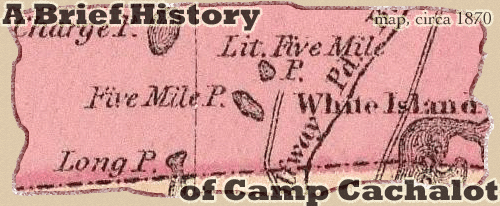
It begins with the name. Cachalot. [1]
On May 13th, 1935, as part of complying with new rules of incorporation for Boy Scout councils in Massachusetts, the New Bedford Council changed its name to the Cachalot Council. The name, derived from the French and Portuguese words for sperm whale, was proposed by Joe Allen, of the [Martha's] Vineyard Gazette, in January of 1933 to honor the history of whaling in New Bedford.
At the time, the Council did own a property that was used as a camp. This property, off Rock O' Dundee Road in South Dartmouth [2], was too small and lacked adequate water sources, both for drinking and swimming. For a short time, from 1937 through 1942, the council shared the summer camp facilities of the Fall River Council [3], but this was deemed "not satisfactory for many reasons." [4] From 1943 through 1945, summer camp was held at Camp Maxim, which was owned by the local Boys Club, and also failed to meet the needs of the program.
In 1945, the Cachalot Council conducted a capital fundraising campaign expressly for the purpose of acquiring a suitable camp. Many local businesses and individuals contributed, and the campaign successfully raised $75,000. At the same time, the council began looking for a suitable property. After considering several properties [5], one of the Rangers in Myles Standish State Forest, whose name is unfortunately lost to history, directed the search committee to a parcel surrounding Five Mile Pond and adjacent to the southeastern corner of the state forest, owned by "The Five Mile Corporation." This corporation, headed by Theodore Steinway (of Steinway & Sons Piano), Albert Hathaway, and Russell Davis, had purchased the property during the Great Depression for a mere $12,000, and agreed to sell it to the council for the same price. The deed was signed over on March 28th, 1946, and preparations immediately commenced to open the Camp for its first summer camp season ever, with Roland Deneault as Camp Director, in summer of the same year.
Next: The Early Years >[1] Which means "sperm whale", not "white whale", and is derived from the French and Portuguese word, Cachalote.
[2] The Rock O'Dundee Road property was described as "Camp Warren" in some documents we have in our archive. The original deed shows that the property was purchased in 1920, and was eventually sold to a Frederick Tucker in 1953.
[3] Presumably at Camp Noquochoke
[4] No specific reasons were given in the document quoted here.
[5] What Might Have Been: Prior to the purchase of the land
that was to become Camp Cachalot, the Cachalot Council did consider
other properties. The most notable of these was an area around Fawn Pond
in Plymouth, Massachusetts, considered in 1945, that was then owned by a
local cranberry grower named LeBaron R. Barker. He had acquired all of
the land surrounding Fawn Pond, whose waters he used for flooding his
cranberry bogs. When the Council expressed interest in the land, he
politely declined, saying that he was comfortable with his current
arrangements.
Three years later, in 1948, Mr. Barker donated a
large portion of that same land, mostly along the north and west shores
of Fawn Pond, to the Squanto Council, who proceeded to move their Scout
camp there from its prior location. This became the third site of Camp
Squanto, which is the principal summer camp for the current Old Colony
Council, which absorbed the Squanto Council in 1970.
All content copyright ©2004- by the Camp Cachalot Alumni Association, except where otherwise noted.
This page was last modified on Wed Feb 24th 2021.
Site look odd? Your browser may not be up to date. See the note on the main page.

